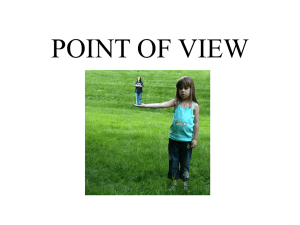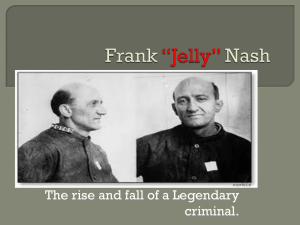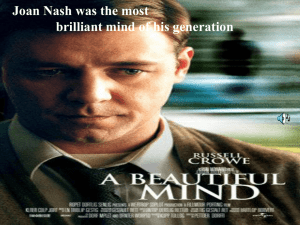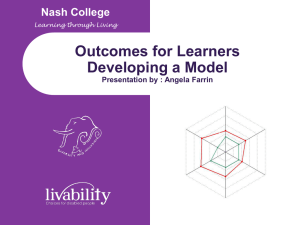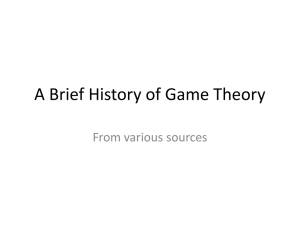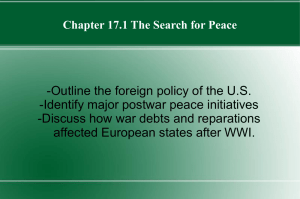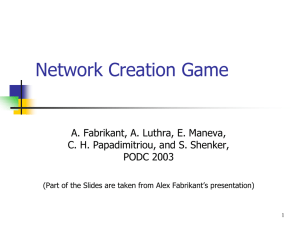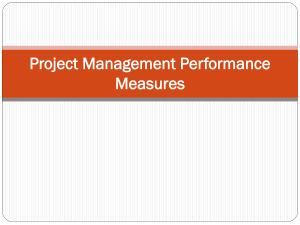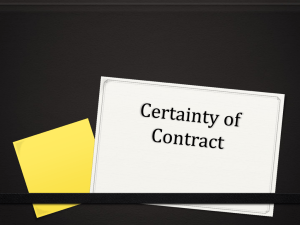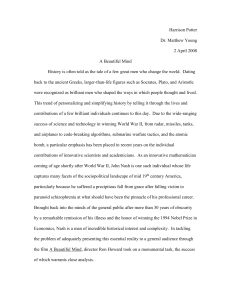Games Results
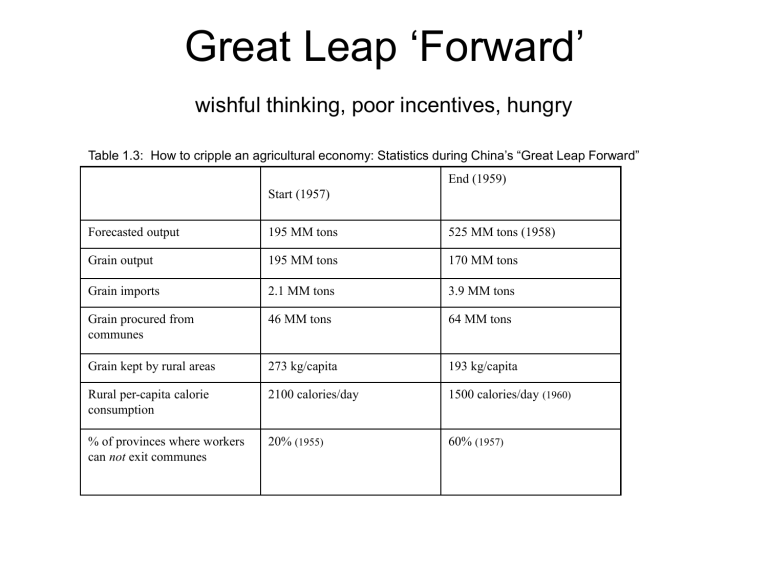
Great Leap ‘Forward’
wishful thinking, poor incentives, hungry
Table 1.3: How to cripple an agricultural economy: Statistics during China’s “Great Leap Forward”
End (1959)
Start (1957)
Forecasted output
Grain output
Grain imports
Grain procured from communes
Grain kept by rural areas
Rural per-capita calorie consumption
% of provinces where workers can not exit communes
195 MM tons
195 MM tons
2.1 MM tons
46 MM tons
273 kg/capita
2100 calories/day
20% (1955)
525 MM tons (1958)
170 MM tons
3.9 MM tons
64 MM tons
193 kg/capita
1500 calories/day
60% (1957)
(1960)
Centralization, I
Table 1.2: Failure rates in public and private expeditions to the North Pole and Northwest Passage (Karpoff, 2001)
Private (n=56)
Public (n=35)
Crew deaths (%) 8.0
Number of ships (number lost) 1.63 (.53)
% with scurvy 46.7%
6.2
1.15 (.24)
13.2%
Unintended consequences
• ...A law enforcement source in Chicago said police see some evidence of soldiers working with gangs here. Police recently stopped a vehicle and found 10 military flak jackets inside. A gang member in the vehicle told investigators his brother was a Marine and sent the jackets home, the source said. (from Sun-Times)
• "We're lowering our standards," [Defense Department gang detective Scott] Barfield said.
• "A friend of mine is a recruiter," he said. "They are being told less than five tattoos is not an issue. More than five, you do a waiver saying it's not gang-related. You'll see soldiers with a six-pointed star with GD [Gangster Disciples] on the right forearm."[....]
• Of particular concern are reports that the Folk Nation, consisting of more than a dozen gangs in the Chicago area, is placing young members in the military in an effort to gather information about weapons and tactics, said FBI Special Agent Andrea Simmons, who is based in El Paso, Texas.
• "Our understanding is that they find members without a criminal history so that they can join, and once they get out, they will have a new set of skills that they can apply to criminal enterprises," Simmons said. "This could be a concern for any law enforcement agency that has to deal with gangs on a daily basis.“
• According to the Tribune, “nearly every one of the cases that we have looked into, it is a young man or woman who thought that the symbol looked cool," said Christopher Grey, spokesman for the Army's Criminal Investigation Command. "We have found some people even get gang tattoos not really knowing what they are, or at least that they have not had any gang affiliation the past."
BEM 146: Some simple games
• Cognitive hierarchy approach
– Iterative
– easy to compute
– Captures individual differences
– Explains when Nash succeeds and fails
• Nash equilibrium
– Players’ maximize, beliefs are accurate (no surprise when results are announced)
– End of a learning process
• Quantal response equilibrium (Palfrey, Goeree)
– Nash+stochastic choice
The thinking steps model
• Discrete steps of thinking
• Step 0’s choose randomly
K-step thinkers know proportions f(0),...f(K-1) *
Normalize g(h)=f(h)/
h=0
K-1 f(h) and best-respond
A j (K)=
m
(s j ,s m ) (P m (0) g(0) + P m (1) g(1)+... P m (K-1)g(K-1)) logit probability P j (K)=exp(
A j (K))/
h exp(
A h (K))
• What is the distribution of thinking steps f(K)?
* alternative: K-steps think others are one step lower (K-1)
Poisson distribution of thinking steps
• Working memory bound f(k)/f(k-1)
1/k
• f(K)= t
K /e t
K! 84 games: median t=1.65
• Heterogeneous (“spikes” in data)
• Steps > 3 are rare (Keynes, Binmore, Stahl et al)
• Steps can be linked to cognitive measures
Poisson distributions for various t
0.4
0.35
0.3
0.25
0.2
0.15
0.1
0.05
0
0 1 2 3 4 number of steps
5 6 t=1 t=1.5
t=2
Dominance-solvable game (Nash,
1,1; CH .73,1)
COLUMN
Left(.95) Right
30, 20 10, 18 Top(.86)
ROW
Bottom 20, 20 20, 18
Dominance-solvable game results
T
B
Nash
CH
Data 06
Data 07
.89
.95
.95
L
30, 20
20, 20
1.00
.11
.05
.05
R
10, 18
20, 18
.00
Nash CH
1.00
.00
.73
.27
Data
06
Data
07
.81
.19
.86
.14
Keynes’s “beauty contest analogy”
• Professional investment may be likened to those newspaper competitions in which the competitors have to pick out the six prettiest faces from a hundred photographs, the prize being awarded to the competitor whose choice most nearly corresponds to the average preferences of the competitors as a whole; so that each competitor has to pick, not those faces which he himself finds prettiest, but those which he thinks likeliest to catch the fancy of the other competitors, all of whom are looking at the problem from the same point of view. It is not a case of choosing those which, to the best of one's judgment, are really the prettiest, nor even those which average opinion genuinely thinks the prettiest. We have reached the third degree where we devote our intelligences to anticipating what average opinion expects the average opinion to be. And there are some, I believe, who practise the fourth, fifth and higher degrees.
(Keynes, GTMEI)
0.4
0.35
0.3
0.25
0.2
0.15
0.1
0.05
0
0.20
0.15
0.10
0.05
0.00
0
Beauty contest results (Expansion,
Financial Times, Spektrum) average 23.07
22 33 50 num bers
100 num be r choice s
(2/3) of average (BEM 07 ave.28)
Table: Data and estimates of t in pbc games
(equilibrium = 0) subjects/game game theorists
Caltech newspaper portfolio mgrs econ PhD class
Caltech g=3 high school
1/2 mean
70 yr olds
Germany
CEOs game p=0.7
Caltech g=2
PCC g=3 game p=0.9
PCC g=2 mean
19
23
23
24
27
22
33
27
37
37
38
39
22
48
49
54 mean median data std dev
21.8
11.1
20.2
16.1
18.7
25.7
18.6
19.9
17.5
20.0
18.8
24.7
29.9
29.0
24.3
29.2
steps of thinking
3.7
3.0
3.0
2.8
2.3
1.8
1.6
1.5
1.1
1.1
1.0
1.0
0.8
0.1
0.1
0.0
1.56
1.30
CDF of bids for $10 with n=2 bidders (bid2) and n=5 (bid5)
Nash: Bid $10 CH: 1-step bid $5 (n=2), $8 (n=5)
Thinking steps in entry games
• Entry games:
Enter or stay out ($.50)
Prefer to enter if n(entrants)<c (earn $1); not enter n(entrants)>c (earn 0)
All choose simultaneously
• Experimental regularity in the 1st period:
Close to equilibrium prediction n(entrants) ≈c
“To a psychologist, it looks like magic”-- D. Kahneman
‘88
Thinking steps in entry games
How entry varies with capacity (c) , experimental data and thinking model
1
0.9
0.8
0.7
0.6
0.5
0.4
0.3
0.2
0.1
0
0 0.1
0.2
0.3
0.4
0.5
0.6
0.7
0.8
capacity entry=capacity experimental data t=1.25
` ` ` `
70 70 80 80 90 90 100
Capacity
Capacity
0+1+2 Level
2-Level
BOS: Canonical mixed-motive game
FL
FH
COLUMN
ML MH
0, 0 10, 30
30, 10 0, 0
Results 07 (male-female)
COLUMN
ML MH (.56)
FL 0, 0 10, 30
FH (.50) 30, 10 0, 0
Matching pennies (Nash .5, .33;
CH .28, .55)
COLUMN
Left (.43)
Top (.63) 0, 10
ROW
Bottom (.37) 20, 0
Right (.57)
10, 0
0, 10
Private information: Hidden information & hidden action
• Hidden information (“adverse selection”)
– Cannot measure pre-contract information
– E.g.: Acquire-a-company problem
– Betting game (Groucho Marx theorem)
– Coin auction
– Insurance market failure
– movie “cold opening”
• How to overcome?
– Measure
– Exclude (insurance)
– Screening or signaling
– Efficient? (e.g. jockeys)
Betting game & Groucho Marx theorem
A
STATE
B C D
1's payoffs +32 -28 +20 -16
2's payoffs -32 +28 -20 +16
1 learns (A,B) or (C,D)
2 learns (A), (B,C) or (D)
Should they bet?
• Figure ?: Professor Rafael Robb: Guilty of hubris and murder or neither?
• A possibly ironic touch comes at the very end of the AP story (“Penn Professor Charged in Wife’s Slaying”, jan 8,
2007):
• Penn officials said earlier that they had arranged for someone else to teach Robb's graduate seminar in game theory this semester.
Insurance company exclusions
•
Air traffic control
Building, moving
Chemical/rubber manufacturing
Circus or carnival work
Concrete or asphalt work
Crop dusting
Firefighting
Furniture and fixtures manufacturing
Lumber work, including wood chopping, timber cutting and working in a sawmill
Migrant labor
Oil well or refinery work
Police work
Roofing
Sandblasting
Sports, semi-pro or professional
Stockyard work, with or without butchering
Stables, all employees
Stunt work
Telecom installation
Transportation and aviation
Tree climbing
Tunnel work
War reporting
Window work at heights exceeding three stories
• Lipitor (cholesterol)
Zocor (cholesterol)
Nexium
(heartburn, ulcers)
Prevacid
(heartburn, ulcers)
Advair (asthma)
Zoloft (depression)
Singulair (asthma)
Protonix
(heartburn, ulcers)
• Hidden action (“moral hazard”)
– Cannot enforce choice of post-contract action
– E.g., trust games
– Air traffic control
Moral hazard in air traffic control?
Table ? : Increases in diagnoses after rule changes in
“Second Career” program for air traffic controllers
(Staten and Umbeck, 1982)
Disorder
Pre-Second
Career
Program
Change incidence
Respiratory
Muscles
Ear,nose,throat
Abdominal
Eye 5.6
Bones and joints 2.3
Cardiovascular 22.1
Neuropsychiatric 10.9
1.9
.5
6.7
16.7
Post-Second
Career
Program Change incidence
% change
1.5
.4
8.0
20.4
7.4
4.6
32.5
27.2
-21
-20
+19
+22
+32
+39
+47
+150
• 2 nd Career program changes in ’74
• 100% of pay if injury is “disabling”
+ 2 yrs job training
• Could choose own
MD or psychologist
• Increase in “system errors” (<3mi or
1000 vertical ft)
• No increase in near misses
How to avoid hidden info & action?
• Monitoring
– WaWa stores, undercover retail checkers
• Reputations
– Internet! (Ebay, dontdatehimgirl.com)
• 3 rd party assurance (“social collateral”)
• Honor code! (Caltech)
• Make moral people
– Socialization?
– Early-childhood nutrition (Adrian Raine Mauritius study) reduces ASPD?
PROFILE CITY VIEWS
.
1 killeen , displaying 1 to 5 of 18581 of alleged cheaters
Velazquez, Joel "Slim, patches,"
0
NEW added: Thursday, 1:47:00 PM
.
2
Beecroft, Bart "bbuzz68"
.
4
NEW added: Thursday, 1:27:00 PM
.
3
Ross, Jonathan "Johnny, JR, Scooby"
NEW added: Thursday, 1:19:00 PM
Harris, Marion "Tyke"
NEW added: Thursday, 1:06:00 PM
.
5
Green, James "MIKE" "Mike, Whitechocotate"
NEW added: Thursday, 12:50:00 PM
Long Beach State, Texas A&M, 11
Miamisburg, USA
Petersburg,
Virginia Beach, Indianapolis,
33
23
31
Theories of human nature
• Crucial for organizational design
• Are people good & need opportunity
(Theory Y) or bad & need constraint
(theory X)? (a la Maslow hierarchy)
• Models:
– States vs traits (sorting good from bad)
– Differences in social preferences
• “self-interest seeking with guile” (opportunism) as limiting case (or ASPD?)
– Social image & moral wriggle room
States vs traits
• Behavior due to situational “states” or personal
(immutable) “traits”?
• Attribution theory (Kelley, Nisbett-Ross):
– (Western) tendency to overestimate effect of global traits & ability to do trait inference (e.g. interviews)
– E.g. question-answer study
– E.g. Asian vs Caucasian “brains vs work” in educational success
– Self-serving tendency to blame state for bad outcome, claim trait credit for good outcome (annual reports, oil company executive pay)
Social preferences
• Will sacrifice money to help/hurt others
• Dictator game
• Ultimatum game
• One view (inequality-aversion):
– Dislike envy & guilt
– Prefer equal shares
• Another view
– Rawlsitarian (like $, minimum, total)
• Best guess?: 40% selfish, 50% conditional cooperators, 10% “saints”
The right view of human nature?
(from Dawes and Thaler 1988)
Ultimatum vs dictator “games” (Forsythe et al 1994)
NB: Dictator games are “weak situations”, more variance
This is your brain on unfairness: Areas that are differentially active facing unfair offers (1-2) versus fair offers (4-5)
(Sanfey et al 04 Science)
Ultimatum offer experimental sites
Ultimatum offers across societies
(mean shaded, mode is largest circle…)
A subject complaining post-experiment
(Zamir, 2000)
Social image
• People do not care directly about others
• People care about how others perceive them
(2 nd -order belief)
– Few large anonymous donations
– Choose $9 or Play $10 dictator game
– Information avoidance
• Dana-Weber-Kuang/Feiler studies
• High-risk people avoiding an AIDS test
• Cross the street to avoid a homeless person
• “Plausible deniability”
• HP Chief Ethics Officer (?): “I shouldn’t have asked”
